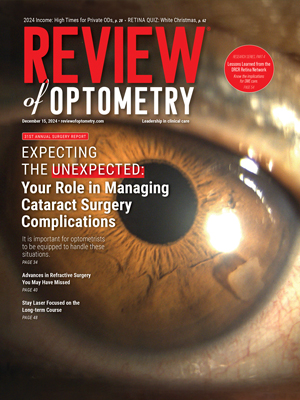| Patients with keratoconus, affected by collagen disease and at risk of lamina cribrosa structural change, must be monitored closely to identify any adverse signs over time. Photo: Christine Sindt, OD. Click image to enlarge. |
Recently, it has been suggested that the compressive effect of the scleral lens on the globe and its support on the sclera may also affect intraocular pressure (IOP), specifically by altering the mechanism of aqueous outflow through the episcleral veins. As such, when considering the other structures of the eye, patients with keratoconus can show modifications of the optic nerve structure at an early stage. Researchers based in Montreal have made the hypothesis that this structure may be more prone to damage if placed under inappropriate pressure. Their recent study, which was published in Ophthalmic and Physiological Optics, aimed to determine the potential impact of scleral lenses on intraocular pressure (IOP) by analyzing the Bruch's membrane opening-minimum rim width (BMO-MRW) while the lenses are worn in a population with keratoconus. BMO-MRW became significantly thinner after six hours of scleral lens wear compared with measurements without lenses. These variations may be associated with a rise in IOP during lens wear.
“To assess IOP during scleral lens wear, we need to look at changes in the optic disc over time,” says study author Langis Michaud, OD. “Taking pressure immediately after lens removal is misleading and does not reflect what happens during lens wear.”
The clinical population comprised 18 keratoconus participants (60% female; age 35.1 years). During the first session, corneal biomechanics was assessed using an air tonometer, coupling Scheimpflug technology. Then, a scan of the optic nerve was carried out using optical coherence tomography (OCT) at two-hour intervals for six hours. These tests were repeated, respecting the time at which the initial measurements were taken, while the scleral lens was worn. Results from only one eye were analyzed. The lenses worn were, on average, designed with a sagittal depth of 4,725μm, a spherical equivalent power of -3.75D (20% were front toric) and the majority (70%) had a 16.0mm diameter, the remainder being 17.0mm diameter. Half of the lenses were designed with bi-elevation and 80% carried toric peripheral curves.
A statistically significant change of 10.5μm in BMO-MRW was observed after six hours of scleral lens wear, compared to measurements without lenses (4.8μm). The fluctuation was greater in participants with keratoconus than found in a previous study of regular corneas.
“We saw a lot of individual variations. So, average does not mean that a single individual will react the same way. It is a patient-by-patient approach,” Dr. Michaud noted. “This does not mean that we can induce glaucoma with scleral lens wear, but we can induce ocular hypertension, with unknown long-term consequences.”
“Based on the results of this study, special attention should be paid to keratoconic patients fitted with scleral lenses,” the study authors wrote in their paper. “Careful evaluation of the optic nerve should be performed on a regular basis, keeping in mind that there was also high variability of results between subjects.”
“This is a different story for those who are already medicated for glaucoma,” Dr. Michaud added. “My advice would be to look at options other than sclerals for them. The last thing to want for them is to generate IOP fluctuations over the day.”
| Click here for journal source. |
Michaud L, Balourdet S, Samaha D. Variation of Bruch's membrane opening in response to intraocular pressure change during scleral lens wear, in a population with keratoconus. Ophthalmic Physiol Opt. December 6, 2024. [Epub ahead of print]. |


